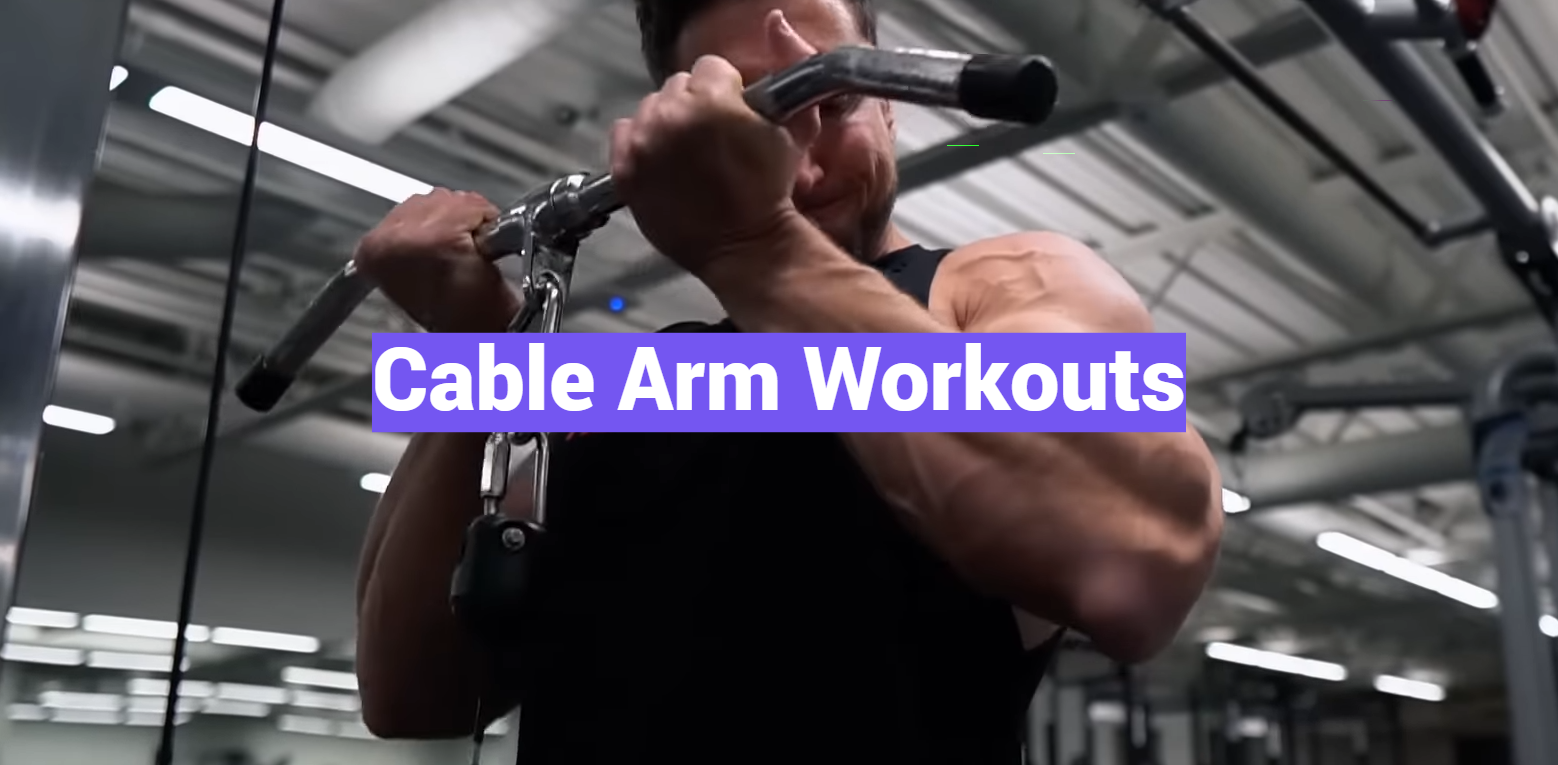In the quest for a well-rounded, comprehensive fitness routine, cable arm workouts emerge as a powerful tool. These workouts engage multiple muscle groups and offer the flexibility to adjust resistance, thereby catering to everyone from fitness novices to seasoned athletes. With the ability to isolate and develop the arm muscles, cable exercises promise enhanced strength and an enviable muscle definition.
What Are Cable Arm Workouts?
When it comes to strength training and building muscles, working out with cables can be a great addition to your routine. Cable arm workouts involve using a cable machine or adjustable pulley system to perform various exercises targeting the arms, shoulders, and back muscles.
Cables are versatile pieces of equipment that provide constant tension throughout an exercise range of motion. This is different from free weights, which rely on gravity to provide resistance. With cables, you can perform a wide range of exercises in different positions and angles, allowing for more targeted muscle activation and development.
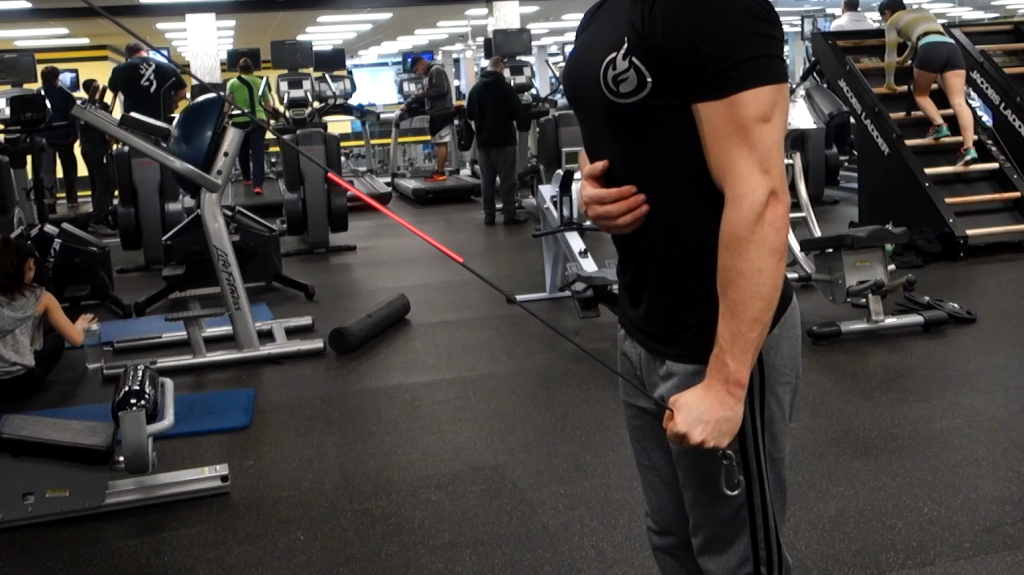
Benefits of Cable Arm Workouts
There are many benefits to incorporating cable arm workouts into your training routine. Here are some of the key advantages:
- Increased Muscular Endurance:Due to the constant tension provided by cables, your muscles have to work harder throughout an exercise. This can help improve muscular endurance over time.
- Balanced Muscle Development:Cables allow you to perform both pushing and pulling movements, helping to balance out muscle development in the arms, shoulders, and back.
- Joint Stability:With cables, you have more control over the direction and angle of resistance, which can help improve joint stability and reduce the risk of injury.
- Variety:Cables provide a wide range of exercise options, allowing for variety in your workouts. This not only keeps things interesting but also helps prevent plateaus in progress. [1]
Types of Cable Arm Exercises
There are countless cable arm exercises that you can incorporate into your workout routine. Here are some of the most effective ones:
- Cable Bicep Curls:Stand facing a cable machine with your feet shoulder-width apart. Grasp the handles with an underhand grip and curl your arms towards your shoulders, keeping your elbows close to your sides.
- Tricep Pushdowns:Stand facing a high pulley on a cable machine with your feet shoulder-width apart. Grasp the handle with an overhand grip and push it downward, focusing on keeping your elbows close to your sides.
- Cable Flyes:Stand facing away from a high pulley on a cable machine with your feet shoulder-width apart. Hold onto the handles with an overhand grip and bring your arms forward in a hugging motion, squeezing your chest muscles at the end of the movement.
- Reverse Cable Crossovers:Stand facing away from a low pulley on a cable machine with your feet shoulder-width apart. Grasp the handles with an overhand grip and pull them towards your sides in a reverse fly motion, targeting your rear deltoids.
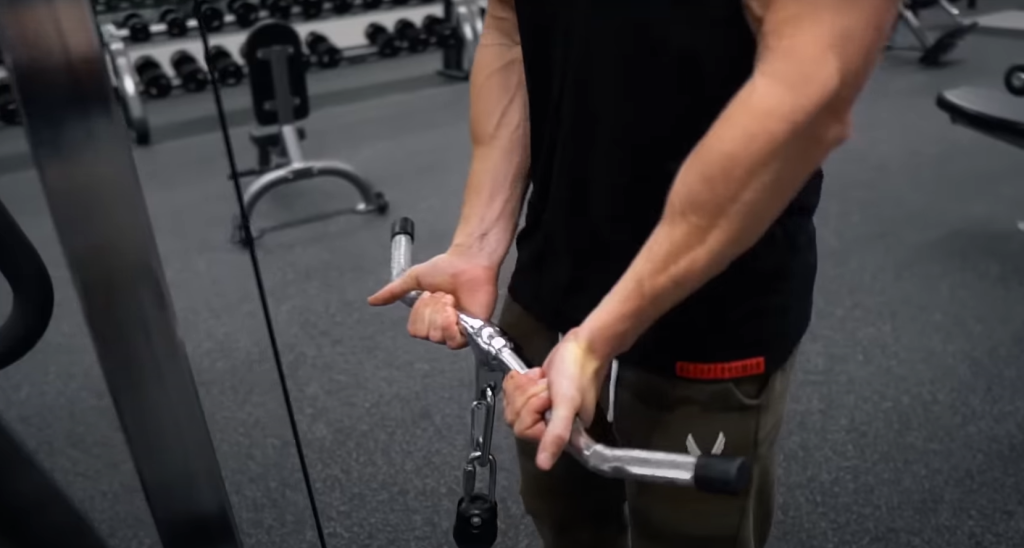
Tips for Effective Cable Arm Workouts
To get the most out of your cable arm workouts, here are some helpful tips to keep in mind:
- Maintain Proper Form:As with any exercise, it’s crucial to maintain proper form to avoid injury and ensure that you’re targeting the intended muscles.
- Use Appropriate Weight:It’s essential to use a weight that challenges you without sacrificing proper form. Gradually increase the weight as your strength improves.
- Vary Your Grip:Switching up your grip can target different muscles and help prevent overuse injuries.
- Incorporate Supersets:Alternating between two or more exercises with little to no rest in between is an effective way to increase intensity and save time during a workout.
How to Perform Cable Arm Workouts Safely
As with any form of exercise, it’s crucial to prioritize safety when performing cable arm workouts. Here are some essential safety tips to keep in mind:
- Warm-Up and Cool Down:Always warm up your muscles before starting a workout and cool down afterward to help prevent injury.
- Start with Light Weights:If you’re new to cable arm workouts, start with lighter weights and gradually increase the intensity as you become more comfortable and confident.
- Listen to Your Body:If you experience pain or discomfort during a workout, stop immediately and assess your form. If necessary, decrease the weight or modify the exercise. [2]
- Consult a Professional:If you’re unsure about how to perform an exercise properly or have any concerns about your form, consult a fitness professional for guidance.
Precautions for Cable Arm Workouts
While cable arm workouts can be an excellent addition to your training routine, there are a few precautions to keep in mind:
- Injuries:Cables provide constant tension and resistance, which can increase the risk of injury if proper form is not maintained.
- Equipment Maintenance:It’s essential to regularly check and maintain cable machines to ensure they’re functioning correctly and safely.
- Overtraining:As with any type of exercise, it’s crucial to allow your muscles time to rest and recover. Overtraining can lead to injury and hinder progress.
Modifications and Variations
There are many ways to modify and vary cable arm exercises to suit your individual needs and goals. Here are a few examples:
- Resistance Bands:If you don’t have access to a cable machine, resistance bands can be used as an alternative for most cable arm exercises.
- Single-Arm Exercises:Performing exercises with one arm at a time can help identify and correct any muscle imbalances.
- Different Angles:Changing the angle of resistance can target muscles in different ways. For example, performing a bicep curl with cables at shoulder level instead of waist level can engage the muscle differently. [3]
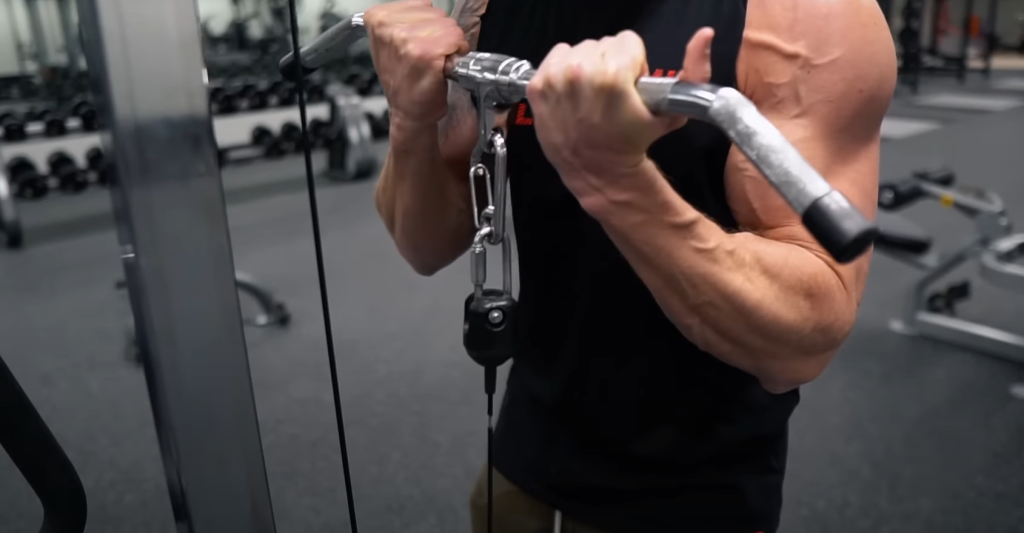
Common Mistakes to Avoid
Here are some common mistakes to avoid when performing cable arm workouts:
- Using Too Much Weight:As mentioned before, using too much weight can compromise form and increase the risk of injury.
- Poor Posture:It’s important to maintain good posture throughout each exercise to ensure that you’re targeting the intended muscles and avoiding strain on other areas of the body.
- Not Controlling the Movement:It’s essential to control the movement throughout each exercise, rather than relying on momentum to perform the movement.
Sample Cable Arm Workout Plan
To help you get started, here’s a sample cable arm workout plan that you can incorporate into your training routine:
- Cable Bicep Curl:3 sets of 10-12 reps
- Tricep Pushdowns:3 sets of 10-12 reps
- Cable Flyes:3 sets of 10-12 reps
- Reverse Cable Crossovers:3 sets of 10-12 reps
- Superset: Cable Hammer Curls and Tricep Pulldowns:3 sets of 10-12 reps each, no rest in between exercises.
When to Incorporate Cable Arm Workouts
Cable arm workouts can be incorporated into your training routine in a variety of ways. Here are some ideas:
- Stand-Alone Workout:You can dedicate an entire workout to cable arm exercises, targeting both biceps and triceps.
- Arm Day:If you have a designated arm day in your training routine, incorporate cable arm exercises into the mix.
- Supersets or Circuits:As mentioned before, incorporating cable arm exercises into supersets or circuits is an effective and time-efficient way to train.
- Full-Body Workouts:Cable arm exercises can also be incorporated into full-body workouts targeting multiple muscle groups at once. [4]
By following these tips, performing cable arm workouts safely and effectively can help you achieve your fitness goals and build strong, toned arms. Remember to always listen to your body, maintain proper form, and consult a professional if you have any concerns or questions. Incorporating cable arm exercises into your training routine can add variety and intensity to your workouts while targeting key muscles in your arms.

Top 15 Popular Cable Arm Exercises and How to Perform Them
1. Cable Bicep Curls
To perform this exercise, stand facing the cable machine with your feet shoulder-width apart and grasp the cable handles using an underhand grip. Keeping your elbows close to your sides, exhale and curl the handles up towards your shoulders while keeping your upper arms stationary. Inhale and slowly lower the handles back to the starting position. Repeat for desired number of reps.
2. Cable Tricep Pushdowns
Begin by standing facing the cable machine with your feet shoulder-width apart and grasping the cable handle with an overhand grip. To ensure proper form, keep your elbows close to your sides. Exhale as you push the handle down towards your thighs, while keeping your upper arms still. Inhale slowly as you release back to the starting position. Repeat for the desired number of repetitions.
3. Cable Hammer Curls
To perform this exercise, position yourself in front of the cable machine with your feet shoulder-width apart. Grasp the handles using a neutral grip, ensuring that your palms are facing each other. Keep your elbows close to your sides throughout the movement. Exhale as you curl the handles up towards your shoulders, maintaining stability in your upper arms. Inhale as you slowly lower the handles back to the starting position. Repeat this sequence for the desired number of repetitions. [5]
4. Cable Tricep Extensions
Begin by standing facing away from the cable machine with your feet shoulder-width apart and grasping the handle with an overhand grip. Keep your elbow close to your head, and exhale as you extend your arm straight down towards the ground until your arm is fully extended. Inhale slowly as you release back to the starting position. Repeat for desired number of reps.
5. Cable Preacher Curls
Assume a position on a preacher bench, placing your chest against the pad. Rest your arms on the edge of the bench and grip the cable handles with an underhand grip. As you curl your arms upwards towards your shoulders, exhale. Keep your upper arms stationary on the bench. Inhale slowly as you lower the handles back to the starting position. Repeat the desired number of repetitions.
6. Cable Overhead Tricep Extensions
Begin by standing facing away from the cable machine with your feet shoulder-width apart. Grasp the handle with an overhand grip and extend your arm above your head, keeping your elbow close to your head. Exhale as you push the handle down towards the ground until your arm is fully extended. Inhale as you slowly release back to the starting position. Repeat for desired number of reps.
7. Cable Concentration Curls
Sit on a bench facing away from the cable machine. Grasp the handle with an underhand grip and rest your elbow on the inside of your thigh. Exhale as you curl the handle towards your shoulder, keeping your upper arm stationary. Inhale slowly as you release back to the starting position. Repeat for desired number of reps before switching arms.
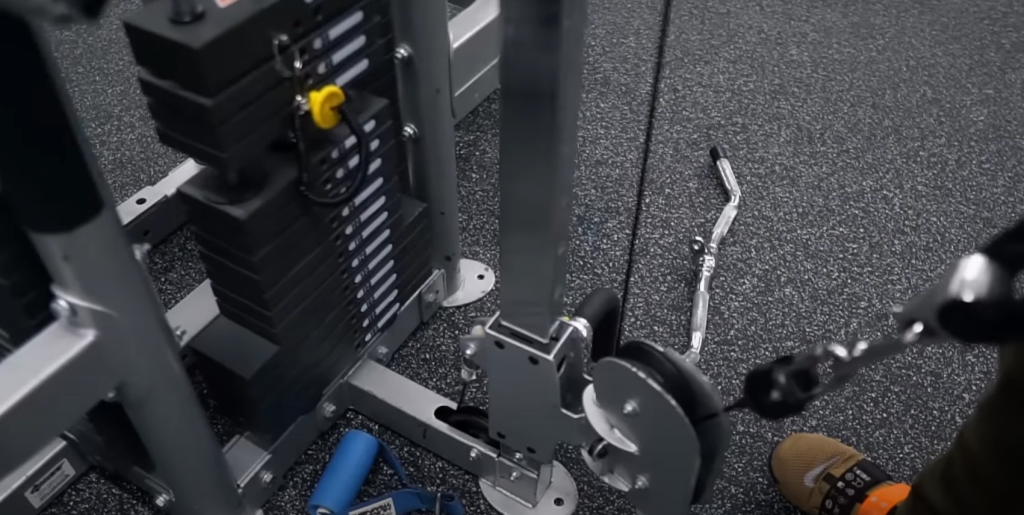
8. Cable Skullcrushers
Lie on a bench facing the cable machine with your feet flat on the ground. Grasp the handle with an overhand grip and extend your arms above your chest, keeping your elbows close to your head. Exhale as you lower the handle towards your forehead, bending at the elbows. Inhale slowly as you extend your arms back to the starting position. Repeat for desired number of reps.
9. Cable Wrist Curls
Stand facing the cable machine with your feet shoulder-width apart and hold onto the handle with an underhand grip. Rest your forearm on a flat bench or on your thigh. Exhale as you curl your wrist towards your body, keeping your upper arm stationary. Inhale as you slowly release back to the starting position. Repeat for desired number of reps before switching arms.
10. Cable Hammer Tricep Kickbacks
Stand facing away from the cable machine with your feet shoulder-width apart and grasp the handle with a neutral grip. Lean forward slightly, keeping your upper arms close to your sides. Exhale as you extend your arms straight back, squeezing your triceps at the top of the movement. Inhale as you slowly release back to the starting position. Repeat for desired number of reps. [6]
11. Cable Wrist Extensions
To perform this exercise, start by standing with your feet shoulder-width apart, facing away from the cable machine. Grasp the handle with an overhand grip and place your forearm on a flat bench or rest it on your thigh. As you exhale, extend your wrist away from your body while keeping your upper arm stationary. Inhale as you slowly return to the starting position. Repeat this movement for the desired number of repetitions before switching arms.
12. Cable One-Arm Preacher Curls
Sit on a preacher bench facing away from the cable machine with your arm extended and your wrist resting on the pad. Grasp the handle with an underhand grip and curl your arm towards your shoulder while keeping your upper arm stationary. Exhale as you curl, then inhale as you slowly release back to the starting position. Repeat for desired number of reps before switching arms.
13. Cable Rope Hammer Curls
Begin by standing in front of the cable machine, ensuring your feet are shoulder-width apart. Grasp the handles of the rope attachment with a neutral grip, keeping your elbows close to your sides. As you exhale, curl the handles towards your shoulders, focusing on squeezing at the peak of the movement. Inhale slowly as you release back to the starting position. Repeat for your desired number of repetitions.
This exercise can also be performed with one arm at a time.
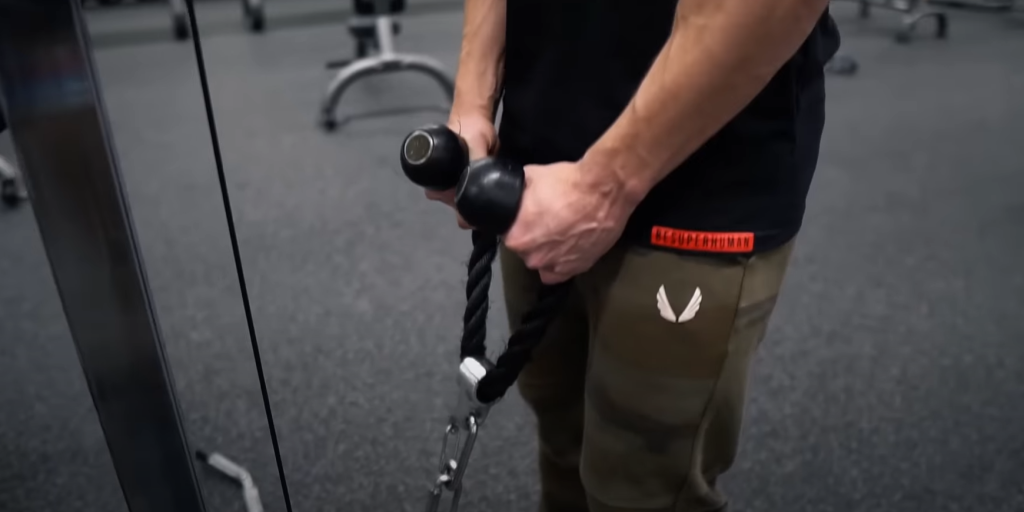
14. Cable High Pulley Curls
To perform this exercise, you will need to attach a rope attachment to the high pulley of the cable machine. Stand facing the machine and grasp the rope handles with an underhand grip. Keep your elbows close to your sides as you curl the handles towards your shoulders, exhaling as you do so. Inhale as you slowly release back to the starting position. Repeat for desired number of reps.
15. Cable Reverse Grip Tricep Pushdowns
Position yourself in front of the cable machine, ensuring your feet are shoulder-width apart. Securely grip the handle with an underhand grip and keep your elbows close to your sides. Exhale as you smoothly push the handle down towards your thighs. Take a slow inhalation as you gradually return to the starting position. Repeat this movement for your desired number of repetitions.
Equipment Needed for Cable Arm Workouts
To perform cable arm workouts, you will need access to a cable machine. This is a type of resistance equipment that uses cables and pulleys to create tension for the exercises. Cable machines are usually found in most gyms, but if you do not have access to one, there are also portable cable machines available for home use.
Other equipment needed for certain exercises may include:
- Bench: for exercises that require a seated or lying position
- Preacher bench: for preacher curls
- Rope attachment: for rope hammer curls and high pulley curls
It is important to choose appropriate weights for the cable machine, as using too much weight can compromise your form and increase the risk of injury. Start with lighter weights and gradually increase as you become more comfortable with the movements.
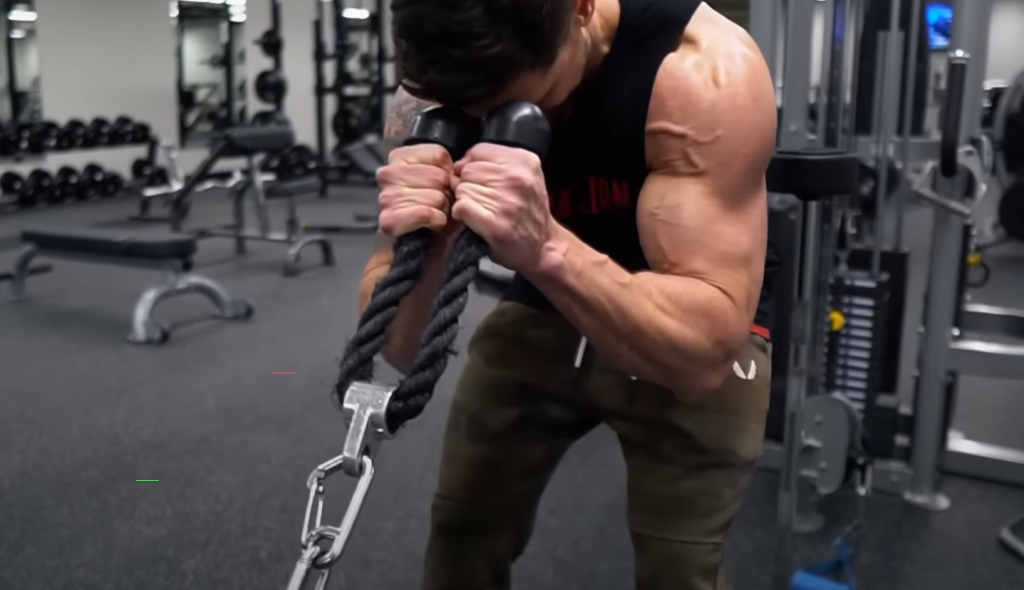
FAQs
What are some effective cable arm exercises?
Some effective cable arm exercises include:
- Cable bicep curls
- Cable tricep pushdowns
- Cable concentration curls
- Cable skullcrushers
- Cable wrist extensions
What muscles do cable arm workouts target?
Cable arm workouts primarily target the biceps, triceps, and forearms. They also engage the shoulders and chest to a lesser extent.
How often should I do cable arm workouts?
It is recommended to do cable arm workouts 2-3 times a week, with at least one day of rest in between sessions. It is important to listen to your body and not overdo it, as proper rest and recovery are essential for muscle growth and injury prevention.
Can I use resistance bands instead of a cable machine?
While resistance bands can be a good substitute for cable machines, they may not provide the same level of tension and stability. It is best to use a cable machine if possible, but resistance bands can still be effective for at-home workouts.
What are some common mistakes to avoid when doing cable arm exercises?
Some common mistakes to avoid when doing cable arm exercises include using too much weight, swinging or using momentum to complete the movement, and not engaging the targeted muscles fully. It is important to maintain proper form and control throughout each exercise for optimal results.
What are the benefits of using cable machines for arm workouts?
- Allows for a full range of motion, engaging the muscles more effectively
- Provides constant tension throughout the movement
- Can be adjusted to target specific muscle groups and individual arms separately
- Can help with stability and balance as compared to free weights or resistance bands.
Are cable arm exercises suitable for beginners?
Yes, cable arm exercises can be suitable for beginners as long as proper form and technique are maintained. It is important to start with lighter weights and gradually increase as strength and proficiency improve. Consulting a trainer or doing research on proper form can also be beneficial for beginners.
Can cable arm workouts help with muscle growth?
Yes, cable arm workouts can help with muscle growth when done consistently and with proper form. They provide a variety of exercises that target different muscle groups and can be adjusted for progressive overload, which is essential for muscle growth.
Can cable arm workouts help improve sports performance?
Cable arm workouts can help improve sports performance by strengthening the muscles used in various athletic movements such as throwing, swinging, or pushing. They also help with stability and balance, which are important for many sports. Overall, incorporating cable arm workouts into a well-rounded fitness routine can contribute to overall strength and improved performance in various activities.
Can I solely rely on cable arm workouts for arm muscle development?
While cable arm workouts can be an effective way to develop arm muscles, it is not recommended to solely rely on them. Varying your workouts with different types of equipment and exercises can help prevent plateaus and engage the muscles in different ways. It is also important to incorporate rest days and proper nutrition for muscle growth and recovery.
What precautions should I take when using cable machines for arm workouts?
Some precautions to take when using cable machines for arm workouts include:
- Always warm up and stretch properly before starting your workout
- Use appropriate weights and do not overload the machine
- Maintain proper form and control throughout each exercise
- Do not let go of the handles or attachments while the machine is in use
- Listen to your body and stop if you feel any pain or discomfort
- Consult a trainer if you are unsure about any exercises or techniques.
Are there any alternative exercises if I don’t have access to a cable machine?
Yes, there are alternative exercises that can be done without a cable machine. Some examples include:
- Bicep curls with dumbbells or resistance bands
- Tricep dips using a bench or chair
- Push-ups for overall arm and chest strength
It is important to research proper form and consult a trainer for these exercises as well to avoid injury.
What is the recommended weight to use for beginners in cable arm workouts?
The recommended weight for beginners in cable arm workouts may vary depending on individual strength and fitness levels. It is important to choose a weight that challenges you but still allows for proper form and control. Starting with lighter weights and gradually increasing as strength improves is the best approach. A trainer or experienced gym-goer can also provide guidance on appropriate weights to use.
Conclusion
After reading this guide, you should now have an understanding of cable arm workouts and how to implement them into your workout routine. Cable machines allow for continuous tension on the muscle group being targeted, making it a great tool for building strength and muscle mass.
In addition to their effectiveness, cable arm workouts can also add variety to your routine. With various grip options and attachments available, you can target different muscles and add a new challenge to your workout.
Remember, proper form is crucial when performing cable arm exercises. Start with lighter weights and focus on perfecting your technique before increasing the weight.
Keep challenging yourself and varying your workouts with different cable machine attachments and exercises to continue seeing progress and gains in your arm muscles. Happy lifting!
Useful Video: Biceps & Triceps Workout for Bigger Arms (CABLES ONLY!) | V SHRED
References:
- https://steelsupplements.com/blogs/steel-blog/the-10-best-cable-exercises-for-your-arms
- https://www.bodybuildingmealplan.com/cable-arm-exercises/
- https://barbend.com/cable-arm-workouts/
- https://www.setforset.com/blogs/news/cable-arm-exercises
- https://boxlifemagazine.com/cable-arm-workouts/
- https://dawnpdarnell.com/5-upper-body-cable-exercises/

